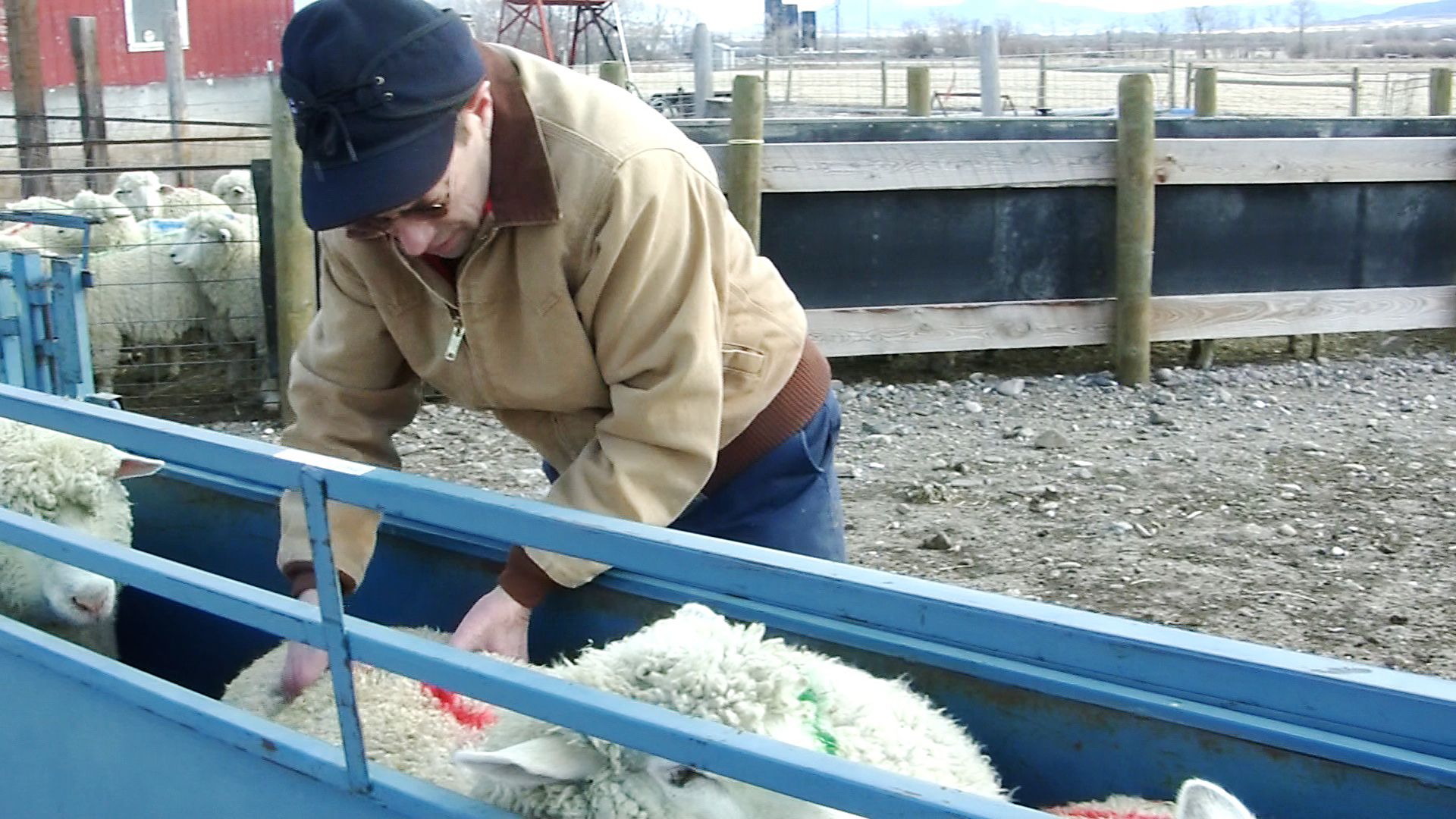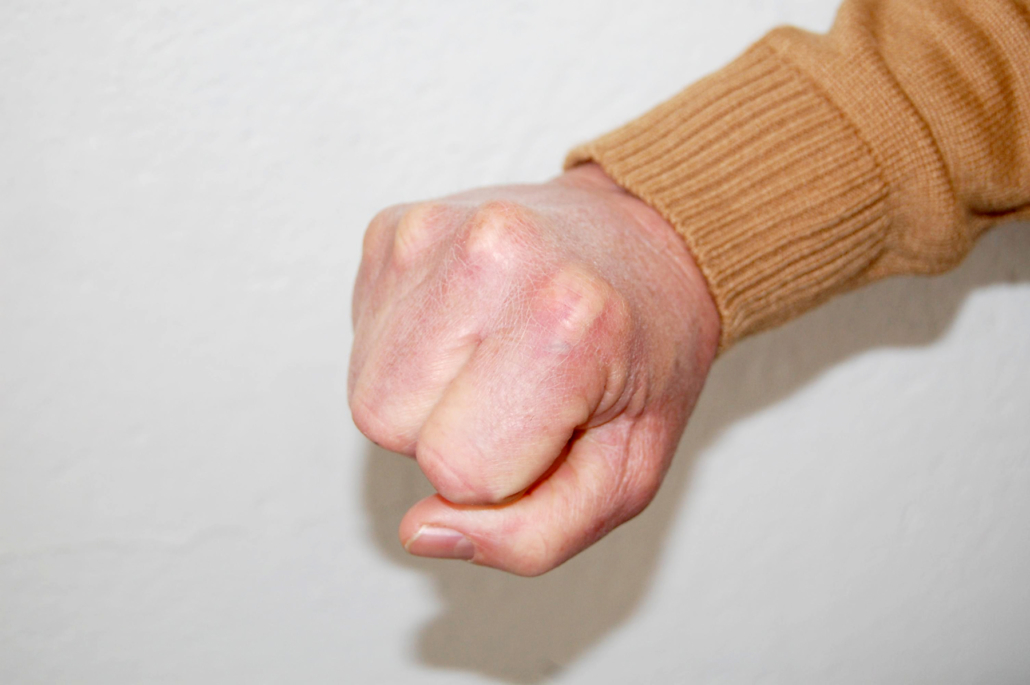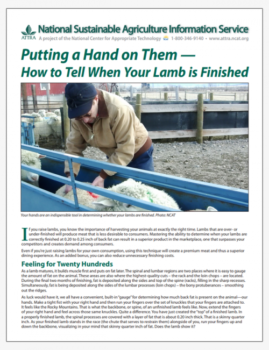Putting a Hand on Them — How to Tell When Your Lamb is Finished

Your hands are an indispensable tool in determining whether your lambs are finished. Photo: NCAT
By Dave Scott, NCAT Livestock Specialist
Introduction
If you raise lambs, you know the importance of harvesting your animals at exactly the right time. Lambs that are over- or under-finished will produce meat that is less desirable to consumers. Mastering the ability to determine when your lambs are correctly finished at 0.20 to 0.25 inch of back fat can result in a superior product in the marketplace, one that surpasses your competitors and creates demand among consumers.
Even if you’re just raising lambs for your own consumption, using this technique will create a premium meat and thus a superior dining experience. As an added bonus, you can also reduce unnecessary finishing costs.
Feeling for Twenty Hundreds
As a lamb matures, it builds muscle first and puts on fat later. The spinal and lumbar regions are two places where it is easy to gauge the amount of fat on the animal. These areas are also where the highest-quality cuts – the rack and the loin chops – are located. During the final two months of finishing, fat is deposited along the sides and top of the spine (racks), filling in the sharp recesses. Simultaneously, fat is being deposited along the sides of the lumbar processes (loin chops) – the bony protuberances – smoothing out the ridges.
As luck would have it, we all have a convenient, built-in “gauge” for determining how much back fat is present on the animal—our hands. Make a tight fist with your right hand and then run your fingers over the set of knuckles that your fingers are attached to. It feels like the Rocky Mountains. That is what the backbone, or spine, of an unfinished lamb feels like. Now, extend the fingers of your right hand and feel across those same knuckles. Quite a difference. You have just created the “top” of a finished lamb. In a properly finished lamb, the spinal processes are covered with a layer of fat that is about 0.20 inch thick. That is a skinny quarter inch. As your finished lamb stands in the race (the chute that serves to restrain them) alongside of you, run your fingers up and down the backbone, visualizing in your mind that skinny quarter inch of fat. Does the lamb show it?

If the backbone of your lamb feels more like this photo, it’s not yet finished. Photo: NCAT
Does the Fat Slip?
When the lamb has 0.20 inch of back fat, you will also be able to feel the fat slide across the backbone in such a way that it seems to “slip” as you move your fingers over the backbone. This is characteristic of 0.20 inch of back fat. Fat covers of less than 0.20 inch will not slip, while covers of 0.30 inch or more will tend to “roll” over the spinal processes instead of slipping. Additionally, a 0.30 inch or greater thickness of back fat seems to move as one whole layer, producing a “jiggling” effect as your hand moves it rapidly.
Incidentally, the show-ring lambs that you exhibit in 4H and FFA events are most often finished to 0.30 inch or more of back fat because they appear more uniform and “polished” in the ring. To the consumer, however, this is too much fat. It can leave a “sticky” feeling on the roof of your mouth and often is an unpleasant dining experience. In fact, this is one of the most common reasons why customers decide not to buy lamb again. It has also caused the lamb industry a lot of grief.

A finished lamb’s backbone would feel more like extended knuckles with no sharp protuberances, as shown in this photo. Photo: NCAT
The lumbar processes on a correctly finished lamb also feel like the knuckles on your extended hand as you move your fingers across them. Often, there will be more fat covering here than over the backbone itself. We have found this to be normal for the genetics in our flock. This trait can vary among breeds of sheep and also among different flocks within the same breed. You will become an expert on your own flock.
Guard against over-finished lambs—process them before they become too fat. If you can consistently produce lamb that is properly finished, you will achieve one of your primary goals: a differentiated product. As such, your lamb will rise above others in the marketplace for its quality.
Checking for Accuracy
If you are fortunate, you know a technician who regularly ultrasounds cattle and sheep. This was our case. Years ago, a technician demonstrated how to ultrasound lambs to our 4H Club members. I also gained more experience as a county livestock judging coach (volunteers with no experience are accepted quite readily). I would have never guessed then how much 4H and FFA livestock judging would later benefit our farm business.
Having the opportunity to examine the hanging carcasses two to three days after you have put a hand on them as live animals is a huge advantage. This is your report card. When you first begin to evaluate live lambs, write down notes as to how they feel. Compare these notes with the hanging carcasses. For example, we go through all of our retail lambs each Saturday afternoon. They go to the processor on the following Monday and we see how well we did by viewing the carcasses on Tuesday. It is extremely helpful if you have a butcher who will take the time to go over the carcasses with you. I have learned a tremendous amount from our butcher. Integrating live animal traits with carcass traits will greatly enhance your ability to provide an excellent product for your customers.
Until you master the technique, you might occasionally misjudge the amount of finish present on your lambs. Don’t get discouraged; just make a mental note and remember the details for next time. Correctly evaluating your finished lambs takes some practice. The more lambs you do, the more skilled you will become. If your finishing season extends for only a few months, you can get rusty in the off season. When I begin with new-crop lambs, I usually have to recalibrate my hands. This is done by checking carcasses.
Having the ability to process your lambs when they are at the height of their maturity distinguishes your lamb in the marketplace and makes you a sought-after supplier of high-quality meat. The technique of putting a hand on your lamb is an important skill toward this end, and one that can easily be learned. It will serve you well.
Want to see this technique in action? Check out the ATTRA video Putting a Hand on Them—How to Tell When Your Lamb is Finished.
Putting a Hand on Them—How to Tell When Your Lamb is Finished
By Dave Scott, NCAT Livestock Specialist
Published March 2014
©NCAT
IP468
Slot 48
This publication is produced by the National Center for Appropriate Technology through the ATTRA Sustainable Agriculture program, under a cooperative agreement with USDA Rural Development. ATTRA.NCAT.ORG.

